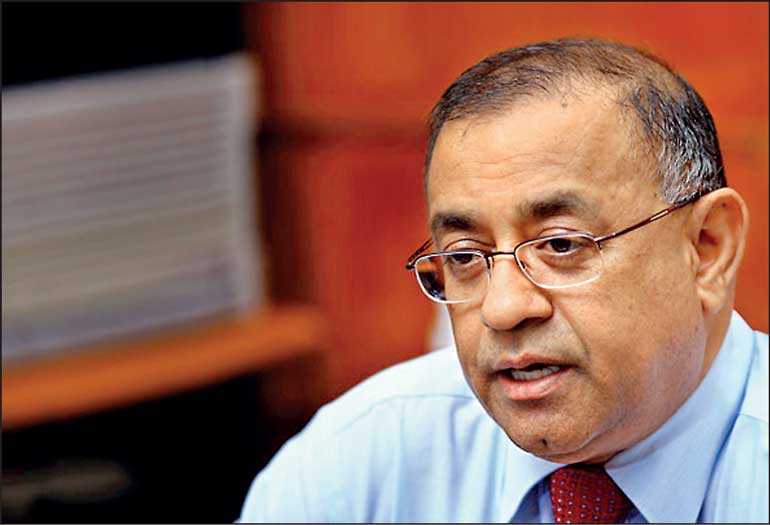Saturday Feb 22, 2025
Saturday Feb 22, 2025
Thursday, 28 May 2020 00:26 - - {{hitsCtrl.values.hits}}

Since independence, Sri Lanka has never experienced a growth rate over 6% continuously for more  than four years. In comparison, the countries that achieved ‘developed’ status in recent decades underwent over 7-8% growth continuously for 20-30 years. Therefore, while there were certain periods when Sri Lanka’s economic performance was relatively better, even at those times it was far from perfect.
than four years. In comparison, the countries that achieved ‘developed’ status in recent decades underwent over 7-8% growth continuously for 20-30 years. Therefore, while there were certain periods when Sri Lanka’s economic performance was relatively better, even at those times it was far from perfect.
PBJ’s formula for economy
On that historical note, it was interesting to note the recent view point of the Secretary to the President (and former Secretary to the Treasury). Undoubtedly he would be one of the key decision makers regarding the economy in the coming years. The salient points of his views are:
1.Support improvement in agriculture
2.Construction to be a thrust sector as it involves SMEs and entrepreneurs in rural areas and employs unskilled daily wage earners, yet not undertake expensive infrastructure projects
3.Focus on smallholder plantations
4.Reduce Government expenditure through efficiency improvements from technology and work from home initiatives
5.Development of exports and import/trading segments should enter export segment
Broadly a continuation of 2005-2014
To me the most exciting and promising of all is the last – shifting non-essential import segment to export segment. However whether there’s a practical plan for that to happen is a different matter. The majority of the rest isn’t too different from the approach of his previous term from 2005-2014. Admittedly, it was one of the ‘better times’ for the economy in the post-independence era (and significantly better compared to the dismal performance from 2015-2019).
While Sri Lanka did record relatively high growth rates during this period, it was predominantly through the peace dividend (with the ending of war in 2009) and a thrust in infrastructure development. While the implementation effectiveness should be commended, the economic benefits of the infrastructure boom are questionable. In summary, while it was better than most other times in the post-independence era, it was by no means flawless economic management.
Sri Lanka had access to more concessionary financing at that time due to the lower per capita income, the absolute foreign debt was lower and the lack of return from the investments in infrastructure has eroded the space to venture into similar investments now. Therefore a similar strategy would not be sustainable in the coming years and is also likely to result in much lower growth rates compared to that era.
Vision from top is necessary
There are clear signs that what may unfold in the coming years is a bottom up strategy. In other words, trying to improve every segment, industry, etc. and expect the country to prosper. Therefore the whole process seems to be delegated to each institution to come up with strategies and mechanisms of implementation. The SOEs have already been assigned to individuals from private sector with the objective of professionalising the management and thereby hoping for improvement.
In my view, the success of this approach would be limited. The better approach would be a top-down one with a vision from the top. This would involve a clear country strategy while prioritising the segments. Based on such prioritising, resources could be allocated. Resources are limited and hence it is not practical to allocate a similar level for each sector. Hence prioritising becomes crucial. With such direction, each entity and segment could then go into detail so that it’s in line with the grand strategy.
The gaping hole in PBJ strategy
Where Sri Lanka has failed compared to the success stories since independence is in terms of advancing in high value add industries by penetrating global markets. This is why Sri Lanka has not generated high paying job opportunities and is stuck in traditional industries and in the process is going through an eternal brain drain. While a lot of lip service has gone into this obvious factor, no meaningful steps have been taken to address it. There are two aspects that we need to understand regarding this:
Firstly, we should be clear as to which markets we should penetrate. The success stories over the last several decades as well as the countries that are doing well currently are penetrating the same set of developed countries (US, Europe, etc.). We need to do the same. Trying to penetrate emerging markets (China, Indonesia, etc.) make little sense, as those markets are actually our competitors rather than potential customers. They have the same credentials as we do, albeit more advanced than us, which means it’s an uphill task to penetrate them.
Secondly, to make inroads to the developed markets, simple supply vs. demand dynamics would not be sufficient. If we are to compete head on with Vietnam, Indonesia and Thailand, the rate of success wouldn’t be great. For us to leap forward, we would need sponsorships – which means ready buyers, relaxing strict supply vs. demand dynamics. This is the same strategy that was adopted by Taiwan, South Korea, etc. during the early stages of their development. To achieve that we could utilise geo political factors smartly. As I have pointed out over and over again, the current trade war between USA and China is an opportunity of a lifetime for Sri Lanka. We would need to incur certain calculated costs, but that’s the most practical way. This is where we have really failed since independence.
This is what is notably absent in the strategies being discussed. We don’t seem to have learnt from our mistakes since independence to take a more rational approach. A 4-5% growth for few years may look impressive compared to the 2-3% growth we achieved over the last five years. However it’s nowhere near the 7-8% sustainable growth needed to make Sri Lanka a noteworthy economy in the world during our lifetime.
(The writer could be contacted on [email protected].)
Discover Kapruka, the leading online shopping platform in Sri Lanka, where you can conveniently send Gifts and Flowers to your loved ones for any event including Valentine ’s Day. Explore a wide range of popular Shopping Categories on Kapruka, including Toys, Groceries, Electronics, Birthday Cakes, Fruits, Chocolates, Flower Bouquets, Clothing, Watches, Lingerie, Gift Sets and Jewellery. Also if you’re interested in selling with Kapruka, Partner Central by Kapruka is the best solution to start with. Moreover, through Kapruka Global Shop, you can also enjoy the convenience of purchasing products from renowned platforms like Amazon and eBay and have them delivered to Sri Lanka.
Discover Kapruka, the leading online shopping platform in Sri Lanka, where you can conveniently send Gifts and Flowers to your loved ones for any event including Valentine ’s Day. Explore a wide range of popular Shopping Categories on Kapruka, including Toys, Groceries, Electronics, Birthday Cakes, Fruits, Chocolates, Flower Bouquets, Clothing, Watches, Lingerie, Gift Sets and Jewellery. Also if you’re interested in selling with Kapruka, Partner Central by Kapruka is the best solution to start with. Moreover, through Kapruka Global Shop, you can also enjoy the convenience of purchasing products from renowned platforms like Amazon and eBay and have them delivered to Sri Lanka.